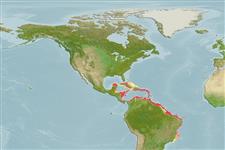>
Clupeiformes (Herrings) >
Pristigasteridae (Pristigasterids)
Etymology: Chirocentrodon: Greek, cheir = hand + Greek, kentron = sting + Greek, odous = teeth (Ref. 45335).
More on author: Poey.
Environment: milieu / climate zone / depth range / distribution range
นิเวศวิทยา
เกี่ยวกับทะเล,น้ำเค็ม; กร่อย; ระดับความลึก 20 - 60 m (Ref. 12225). Tropical; 24°N - 25°S, 90°W - 32°W (Ref. 188)
Western Atlantic: Cuba, Haiti, Jamaica, Puerto Rico, Trinidad; Panama and coasts of Venezuela, including off Orinoco mouth, Guyana, Suriname south to Ubatuba, near Santos, Brazil. Antilles and southern Caribbean from Yucatan to Santos, Brazil (Ref. 26938).
Length at first maturity / ขนาด / น้ำหนัก / Age
Maturity: Lm 7.6 range ? - ? cm
Max length : 16.1 cm TL เพศผู้/กระเทย; (Ref. 118626); common length : 9.0 cm TL เพศผู้/กระเทย; (Ref. 5217); น้ำหนักสูงสุดที่มีการรายงาน: 19.30 g (Ref. 118626)
เงี่ยงครีบหลัง (รวม): 0; เงี่ยงครีบก้น 0; ก้านครีบอ่อนที่ก้น: 38 - 44. Belly with 16 or 17 (rarely 19) + 9 to 11, total 26 to 28 (rarely 30) scutes. Lower jaw not strongly projecting; strong conical teeth in both jaws, continued as large and small teeth along maxilla blade. Easily recognized by large, canine-like teeth in both jaws (Ref. 26938). Dorsal fin origin behind midpoint of body; anal fin moderately long, its origin below or in front of dorsal fin origin.
Occurs in coastal areas, but also in lagoons and off river mouths, perhaps entering water of lowered salinity (Ref. 12225). In Southwestern Atlantic preys on proportionally large clupeoid fishes and caridean shrimps. Fishes are distinctively folded in the stomachs of this herring, in about 90% of the cases with their heads and tails pointing head-wards the predator. This herring stands out as the only small-sized species among the predaceous fish-eating clupeiforms. The well developed canine-like teeth are likely related to a piscivorous diet and may play a role in the folding and orientation of fish during prey handling and swallowing (Ref. 51383). Spawns during the northern winter (Ref. 37032).
Life cycle and mating behavior
วัยเจริญพันธุ์ | การสืบพันธุ์ | การวางไข่ | เซลสืบพันธ์ของเพศเมีย(ไข่) | ความดกของไข่ | ตัวอ่อน
Whitehead, P.J.P., 1985. FAO Species Catalogue. Vol. 7. Clupeoid fishes of the world (suborder Clupeoidei). An annotated and illustrated catalogue of the herrings, sardines, pilchards, sprats, shads, anchovies and wolf-herrings. FAO Fish. Synop. 125(7/1):1-303. Rome: FAO. (Ref. 188)
IUCN Red List Status (Ref. 130435)
Threat to humans
Harmless
Human uses
การประมง: การประมงยังชีพ
ข้อมูลเพิ่มเติม
ชื่อสามัญชื่อพ้องกลไกการเผาผลาญพลังงานผู้ล่าการศึกษาเกี่ยวกับผลกระทบของสารประกอบทางเคมีที่เป็นอันตรายต่อสิ่งมีชีวิต ประชากร และสิ่งแวดล้อมการสืบพันธุ์วัยเจริญพันธุ์การวางไข่การรวมกลุ่มวางไข่ความดกของไข่เซลสืบพันธ์ของเพศเมีย(ไข่)Egg development
อ้างอิงการเพาะเลี้ยงสัตว์น้ำประวัติการเพาะเลี้ยงสัตว์น้ำสายพันธุ์พันธุศาสตร์ElectrophoresesอัตราพันธุกรรมโรคการแปรรูปNutrientsMass conversion
ผู้ร่วมมือรูปภาพหลายรูปStamps, Coins Misc.เสียงปลามีพิษ เช่น ปลาปักเป้าความเร็วรูปแบบการว่ายน้ำพื้นที่เหงือกOtolithsสมองวิสัยทัศน์
เครื่องมือ
Special reports
Download XML
แหล่งที่มาจากอินเตอร์เน็ต
Estimates based on models
Preferred temperature (Ref.
123201): 25.2 - 27.7, mean 27.1 °C (based on 45 cells).
Phylogenetic diversity index (Ref.
82804): PD
50 = 1.0000 [Uniqueness, from 0.5 = low to 2.0 = high].
Bayesian length-weight: a=0.00427 (0.00298 - 0.00611), b=3.02 (2.92 - 3.12), in cm total length, based on LWR estimates for this species (Ref.
93245).
ระดับชั้นอาหาร (Ref.
69278): 3.3 ±0.43 se; based on food items.
ความสามารถในการกลับคืนสู่ปกติ (Ref.
120179): ความสูง, เวลาต่ำสุดที่จะทำให้ประชากรเพิ่มขึ้นเป็น 2 เท่าใช้เวลาน้อยกว่า 15 เดือน (Preliminary K or Fecundity.).
Fishing Vulnerability (Ref.
59153): Low vulnerability (10 of 100).
